Calculation of the Incompressible Viscous Fluid Flow in Piston Seals of Piston Hybrid Power Machines
Abstract
:1. Introduction
- -
- fluid flow is steady, isothermal between solid impermeable walls;
- -
- the mass terms of the equation of motion are negligible (they should be taken into account only when the fluid flows on a free surface or when the fluid density is inhomogeneous);
- -
- -
- value is less then value and it can be neglected;
- -
- transverse pressure gradient is negligible;
- -
- all members containing coordinate (coordinate in the transverse direction) and derivatives with respect to are discarded.
- To analyze gap seals used in hybrid power machines and select the most structurally simple from them and effective in operation.
- To determine the basic geometric and operational parameters for the selected types of gap seals.
- To determine the flow patterns in them based on existing recommendations.
- To calculate the laminar and turbulent flow modes. To determine the most suitable turbulence models for the turbulent flow mode and conduct a comparative analysis of the effectiveness of their application based on a comparison with the results of experimental studies and known physical concepts.
2. Analysis of the Main Types of Piston Seals Used in PHPM
3. Theoretical Research
- The suction pressure in the compressor and pump section was always assumed to be the same and equal to 0.1 MPa.
- The discharge pressure in the compressor and pump sections was in the range from 0.3 to 1.0 MPa. To conduct theoretical research and to compare the flow rates of fluid in the forward and return directions, we assume that Pdp = Pdc = 1 MPa (where Pdp is discharge pressure in the pump section; Pdc discharge pressure in the compressor section).
- The piston diameter of the studied PHPM was from 0.04 to 0.06 m. We assume that the piston diameter is 0.04 m in these studies.
- The length of the piston actually determines the length of the piston seal. It varies in different PHPM designs. We assume that the length of the piston is 0.04 m in these studies.
- The magnitude of the radial clearance is one of the most important parameters. It was shown in [24] that the rational values for a smooth gap seal for a crosshead free PHPM are (20 ÷ 30) μm. It was proved in [25] that rational clearances δ1 and δ2 are (30 ÷ 55) μm and (80 ÷ 110) μm for a step-type piston seal in a crosshead PHPM respectively. In this paper, we assume that δ1 is 25 μm, and δ2 is 50 μm, i.e., those values are close to rational.
3.1. Laminar Fluid Flow
3.2. Turbulent Fluid Flow
- -
- continuity equation:
- -
- Navier-Stokes equation:where V is velocity vector.
3.3. Turbulence Model
- Instability of work with flows having a large pressure gradient and a powerful degree of turbulence.
- This model gives an overestimated value of kinetic energy at high speeds of movement of the working fluid.
3.4. Turbulence Model
3.5. Turbulence Models SST
4. Data Analysis
4.1. Implementation Features
4.2. Smooth Gap Seal
4.2.1. Laminar Flow
- Speed distribution by model is significantly better than laminar model. The discrepancy in determining the maximum speed model is 2 m/s, i.e., 28.4%. The discrepancy in determining the maximum speed of the laminar model is 3.5 m/s, i.e., 50%.
- The Reynolds numbers determined by different models are in the range from 120 to 210, which allows supposing that there is a laminar flow mode in the gap seal. It should be noted that this conclusion could be made from the previously considered results (velocity diagrams).
- The maximum average velocities of 4.234 and 4.174 m/s are observed using the SST and RSM turbulence models. These average velocities exceed significantly (almost by 0.5 m/s) the average velocities determined by calculation for the laminar fluid flow in the gap [3], and according to the turbulence model .
- The lowest average velocity of 2.404 m/s is shown by the laminar fluid flow model which is almost 1.3 m/s less than the theoretically calculated.
- model shows the closest to theoretically calculated values by the definition of average velocity. The discrepancy in determining the average velocity, compared with the theoretically determined one, is 0.033 m/s or 0.88%, i.e., less than 1%. The discrepancy in the definition of average velocities is equivalent to the discrepancy in the definition of volumetric costs presented in Table 2.
4.2.2. Turbulent Flow
- The maximum values of velocities are almost doubled and amount to (12 ÷ 13) m/s. The highest maximum velocity is observed in the RSM model. The differences between the maximum values of the fluid flow rate, determined by the RSM and SST models, are about 1 m/s, while they practically coincided in laminar flow.
- The lowest maximum speed is observed when using the laminar model. It is about 5 m/s, which is more than two times less than the maximum speed obtained by the RSM model.
- The average velocities calculated from the considered flow models are significantly less than the average velocity determined experimentally. The average velocity determined by the SST model is the closest value.However, the discrepancy is 1.83 m/s, which is 15.67%.
- The lowest average velocity of 4.66 m/s is shown by the laminar model, which is less than two times less than the velocity determined experimentally.
- It should be noted that the Re number determined by the average velocity for all turbulence models is less than 1000. Only the Re number determined by the average velocity determined on the basis of experimental data is more critical than the number Recr (Recr = 1000) and is 1160. This suggests that we are generally in the transition area between the laminar and turbulent flow modes.
4.3. Step-Type Gap Seal
4.3.1. Laminar Flow
- The RSM model is the only turbulence model that has lower velocity and lower flow rate during sudden expansion (forward flow) compared to sudden compression (reverse flow).
- Taking into account that the RSM model describes correctly qualitatively and quantitatively the fluid flow in a step-type gap seals, the RSM model is to be used when calculating a step seal in laminar mode.
4.3.2. Turbulent Flow
- The smallest discrepancy between the results of experimental studies and flow models is observed when using the RSM model and it is 0.15 m/s, which is 4.3%.
- Using the SST and laminar models, it is possible to determine the average fluid flow rate with approximately the same error of 0.39 m/s, i.e., 11.33%.
- flow model has the worst results. The discrepancy in determining the average velocity is 0.64 m/s, which is 18.6%.
- The laminar flow model has the highest maximum speed, as in the case of a direct flow, but this value is less than in a direct flow.
- The SST flow model increased its maximum velocity compared to the direct flow, and the velocity distribution diagram almost coincided with the laminar velocity distribution diagram.
- Velocity distribution plots for and RSM turbulence models have a qualitative and quantitative coincidence in the forward and reverse flows.
- The average velocities and flows obtained using the laminar and SST flow models are approximately the same in the opposite direction of the flow, as well as in the forward direction and they are equal to 3.77 m/s, the difference between the experimental value is 0.33 m/s or 9.6%.
- The largest discrepancy between the experimental results and the flow model in average velocity and flow in the forward and reverse directions is observed when using the model.
5. Conclusions
- As a result of the analysis of existing gap seals, two seals were selected: a simple annular gap with a constant gap and an annular gap with a stepwise change in the gap. These types of gap seals are structurally simple, as well as highly efficient from the point of view of ensuring a high mass flow ratio in the forward (from the pump section to the compressor) and reverse directions (from the compressor section to the pump).
- The analysis of the existing pressure drops acting on gap seals has established that the pressure drop is within 1.0 MPa, and the slot in the gap reaches 100 μm. With these parameters, both laminar and turbulent fluid flow modes can be implemented in hybrid power machines.
- The calculation of the flow of laminar and turbulent fluid flow in the gap seal in the forward and reverse directions. An analysis of existing turbulence models is carried out for a turbulent flow; the main models are selected that are widely used in the calculation of fluid flows, including seals and the features of their implementation in the ANSIS CFX package considered. The article provides calculations for the main models: laminar, , and RSM. A comparison of the velocity distribution diagrams in the gap for laminar and turbulent flows in the forward and reverse directions, average fluid velocities, and flow rates in a gap seal is carried out. The results of experimental studies are also compared. The results of the analysis on using various flow models for calculating gap seals of hybrid power machines of volumetric action are presented in Table 9. Each column presents two models showing the best result in the velocity distribution in the gap, average speed, flow rate and adequacy to known physical concepts.
- To calculate the piston seals of hybrid power machines proceeding from the results proposed in Table 9, RSM turbulence models should be used, as the most accurately determining the speed, flow rate and physical flow pattern.
- Further development of the presented studies is possible by considering the unsteady fluid flow in the gap seal and taking into account the inertia forces on the flow characteristics. This is very important because the pressure in the pump and compressor cavities vary significantly in the angle of rotation of the shaft.
Author Contributions
Funding
Conflicts of Interest
References
- Shcherba, V.E.; Bolshtyanskii, A.P.; Kaigorodov, S.Y.; Kuzeeva, D.A. Benefits of Integrating Displacement Pumps and Compressors. Russ. Eng. Res. 2016, 36, 174–178. [Google Scholar] [CrossRef]
- Nikitin, G.A. Slit and Labyrinth Seals of Hydraulic Units; M. Mashinostroyeniye: Moscow, Russia, 1982; p. 135. [Google Scholar]
- Loitsyanskii, L.G. Mechanics of Liquids and Gases: International Series of Monographs in Aeronautics and Astronautics: Division II: Aerodynamics; Pergamon Press: Oxford, UK, 1966. [Google Scholar]
- Kundu, P.K.; Cohen, I.M.; Dowling, D.R. Fluid Mechanics; Academic Press: London, UK, 2012. [Google Scholar] [CrossRef]
- Girgidov, A.D. Mechanics of Fluid and Gas (Hydraulics); Higher Education: Undergraduate; SIC INFRA-M: Moscow, Russia, 2014; 704p, ISBN 978-5-16-009473-1. Available online: https://znanium.com/catalog/product/443613 (accessed on 24 February 2020).
- Basniev, K.S.; Dmitriev, N.M.; Chilingar, G.V. Mechanics of Fluid Flow; Scrivener Publishing: Austin, TX, USA, 2012. [Google Scholar]
- Snegiryov, A.Y. High Performance Computing in Technical Physics. Numerical Modeling of Turbulent Flows; Izd-vo Politekhn. un-ta: Moscow, Russia, 2009; p. 143. [Google Scholar]
- Pope, S.B. Turbulen Flows; Cambridge University Press: Cambridge, UK, 2000. [Google Scholar]
- Fröhlich, J.; von Terzi, D. Hybrid LES/RANS methods for the simulation of turbulent flows. Prog. Aerosp. Sci. 2008, 44, 349–377. [Google Scholar] [CrossRef]
- Menter, F.R. Review of the shear-stress transport turbulence model experience from an industrial perspective. Int. J. Comput. Fluid Dyn. 2009, 23, 305–316. [Google Scholar] [CrossRef]
- Spalart, P.R. Philosophies and fallacies in turbulence modeling. Prog. Aerosp. Sci. 2015, 74, 1–15. [Google Scholar] [CrossRef]
- Larsson, J.; Kawai, S.; Bodart, J.; Bermejo-Moreno, I. Large eddy simulation with modeled wall-stress: Recent progress and future directions. Mech. Eng. Rev. 2015, 3, 15-00418. [Google Scholar] [CrossRef] [Green Version]
- Menter, F.R.; Smirnov, P.E.; Liu, T.; Avancha, R. A One-Equation Local Correlation-Based Transition Model. Flow Turbul. Combust. 2015, 95, 583–619. [Google Scholar] [CrossRef]
- Shcherba, V.E.; Shalai, V.V.; Pavlyuchenko, E.A.; Vinichenko, V.S. Mathematical modeling of the workflows of a reciprocating compressor with intensive cooling of the cylindrical piston group. Chem. Pet. Eng. 2015, 51, 260–267. [Google Scholar] [CrossRef]
- Scherba, V.E.; Bolshtyansky, A.P.; Shalai, V.V.; Khodoreva, E.V. Pump—Compressors; Workflows and design basics; M. Maschinostroyniye: Moscow, Russia, 2013; p. 368. [Google Scholar]
- Shcherba, V.E.; Bolshtyanskii, A.P.; Nesterenko, G.A.; Kondyurin, A.Y. The relationship between the mass flow rates of a liquid and the discharge pressures in the pumping cavity and in the compressor cavity of a hybrid energy-converting piston machine. Chem. Pet. Eng. 2016, 52, 274–279. [Google Scholar] [CrossRef]
- Shcherba, V.E.; Shalai, V.V.; Nosov, E.Y.; Kondyurin, A.Y.; Nesterenko, G.A.; Tegzhanov, A.S.; Bazhenov, A.M. Comparative Analysis of Results of Experimental Studies of Piston Hybrid Energy-Generating Machine with Smooth and Stepped Slot Seals. Chem. Pet. Eng. 2018, 54, 499–506. [Google Scholar] [CrossRef]
- Shcherba, V.E.; Nesterenko, G.A.; Pavlyuchenko, E.A.; Vinichenko, V.S. Analysis of compressor-pump piston seal formed from concentric slit with isoleted channel in piston body. Chem. Pet. Eng. 2014, 50, 105–112. [Google Scholar] [CrossRef]
- Kondyurin, A.Y.; Shcherba, V.E.; Shalai, V.V.; Noskov, A.S.; Khait, A.V. Calculation of liquid flow through pump- compressor slot seal made in the form of hydrodiode. Chem. Pet. Eng. 2016, 52, 267–273. [Google Scholar] [CrossRef]
- Kondyurina, A.Y.; Shcherba, V.E.; Shalai, V.V.; Lysenko, E.A.; Nesterenko, G.A.; Surikov, V.I. Experimental research results of the slot seal constructed as hydrodiode for the hybrid power piston volumetric machine. Procedia Engineering. 2016, 152, 197–204. [Google Scholar] [CrossRef] [Green Version]
- Shcherba, V.E.; Shalai, V.V.; Grigor’ev, A.V.; Kondyurin, A.Y.; Lysenko, E.A.; Bazhenov, A.M.; Tegzhanov, A.S. Analysis of results of theoretical and experimental studies of the influence of radial gaps in stepped slot seal of piston hybrid energy-generating machine. Chem. Pet. Eng. 2018, 54, 666–672. [Google Scholar] [CrossRef]
- Bazhenov, A.M.; Shcherba, V.E.; Kondyurin, A.Y.; Bolshtyansky, A.P.; Lysenko, E.A. Piston Hybrid Power Machine with Step Compaction. Russian Federation Patent 2660982, 7 November 2016. IPC F 04 B 19/06, IPC F 04 B 53/02; applicant and patent holder OmSTU; No. 2016147655; declared 12/05/2016; publ. 07/11/2018, Bull. Number 20. [Google Scholar]
- Kondyurin, A.Y.; Shcherba, V.E.; Shalai, V.V.; Noskov, A.S.; Khait, A.V. Analysis and optimization of basic geometric parameters of annular slot seal made in the form of hydrodiode. Chem. Pet. Eng. 2016, 52, 280–289. [Google Scholar] [CrossRef]
- Shcherba, V.E.; Shalai, V.V.; Nosov, E.Y.; Averyanov, G.S.; Linkov, M.E. Experimental studies of the working processes of a reciprocating hybrid power machine with a slot seal of step-type with various working fluids. In Proceedings of the 12th International Scientific and Technical Conference on Applied Mechanics and Systems Dynamics, AMSD 2018, Omsk, Russia, 13–15 November 2018. [Google Scholar]
- Shcherba, V.E.; Lysenko, E.A.; Nesterenko, G.A.; Grigor’ev, A.V.; Kondyurin, A.Y.; Bazhenov, A.M. Development and investigation of a piston seal in the form of a smooth stepped groove for a volumetric hybrid energy-converting piston machine. Chem. Pet. Eng. 2016, 52, 290–296. [Google Scholar] [CrossRef]
- Garnier, E.; Adams, N.; Sagaut, P. Large Eddy Simulation for Compressible Flows; Springer: Berlin, German, 2009; p. 276. [Google Scholar]
- Wilcox, D.C. Turbulence Modeling for CFD; DCW Industries: La Canada Flintridge, CA, USA, 1994; p. 460. [Google Scholar]
- Ferziger, J.H.; Peric, M.; Robert, L. Street Computational Methods for Fluid Dynamics; Springer International Publishing: New York, NY, USA, 2020. [Google Scholar]


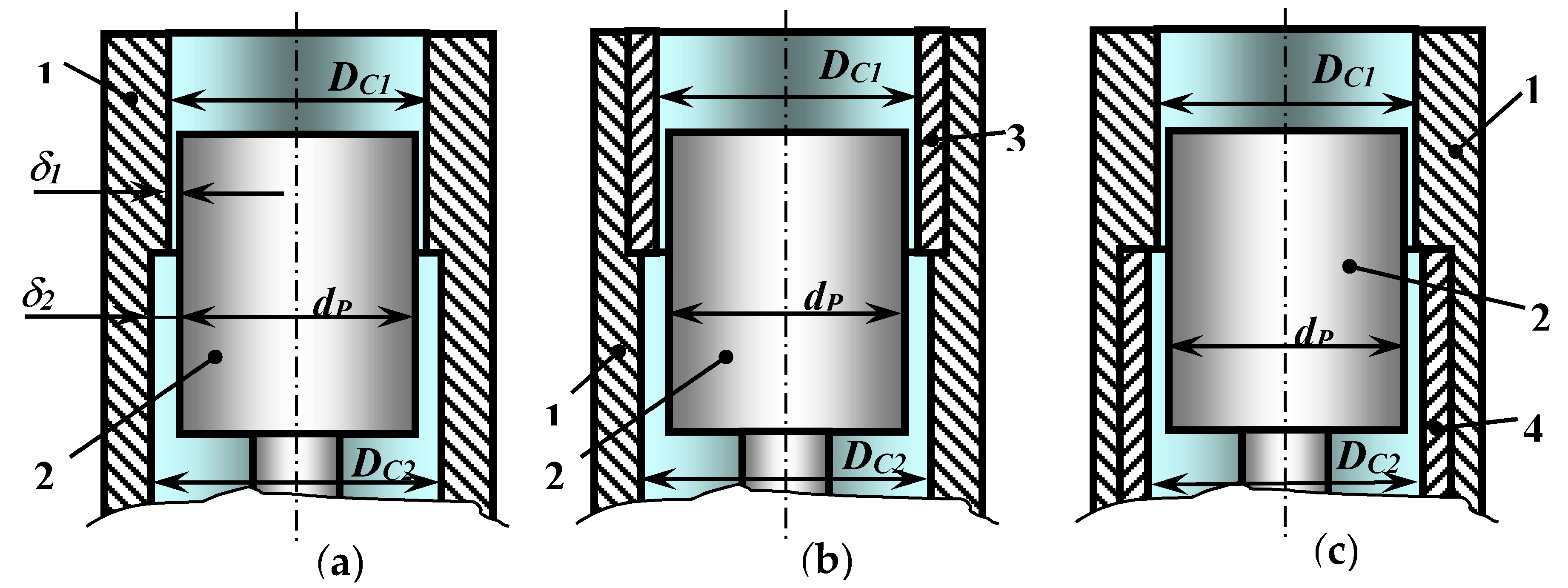


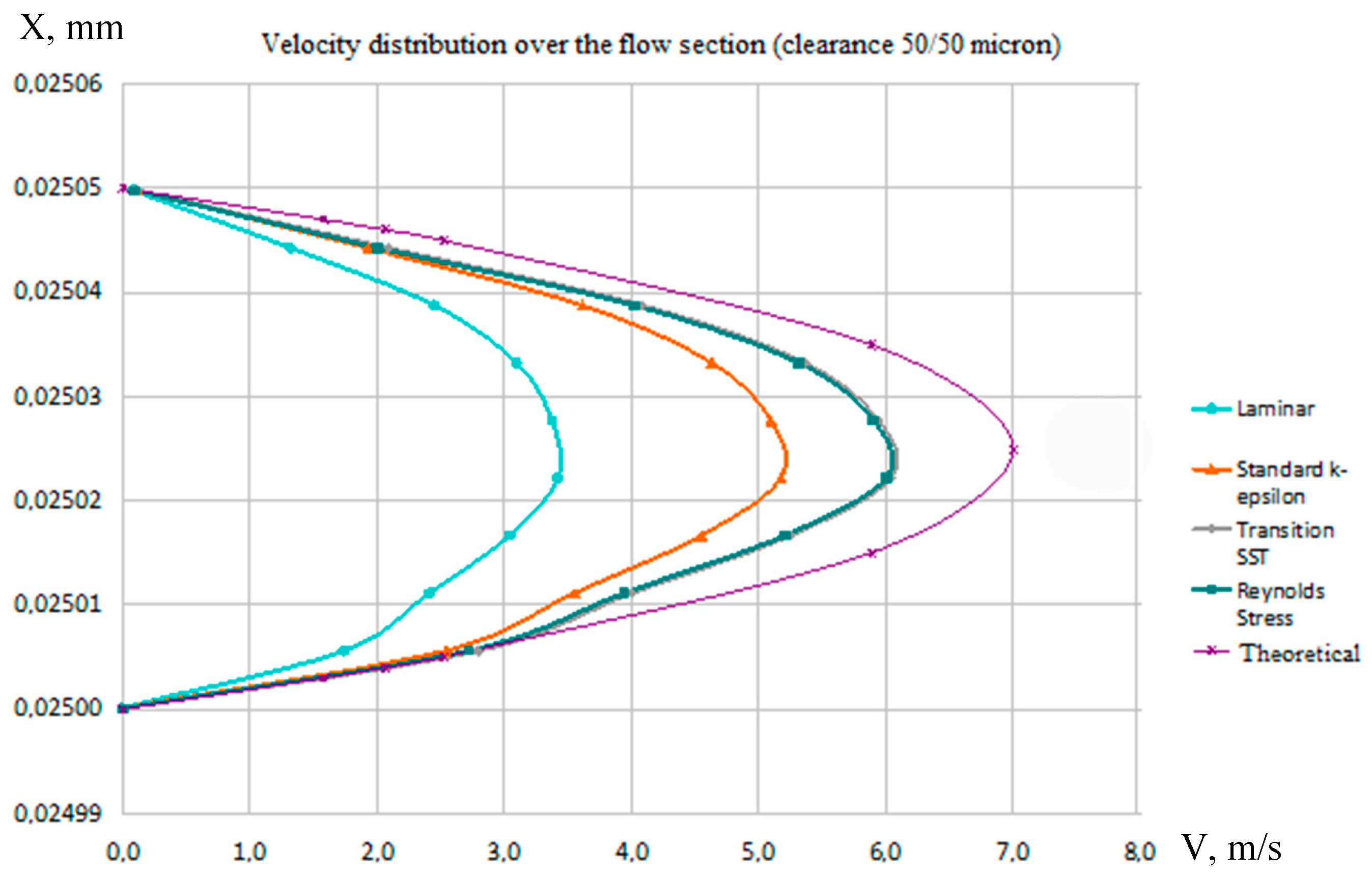
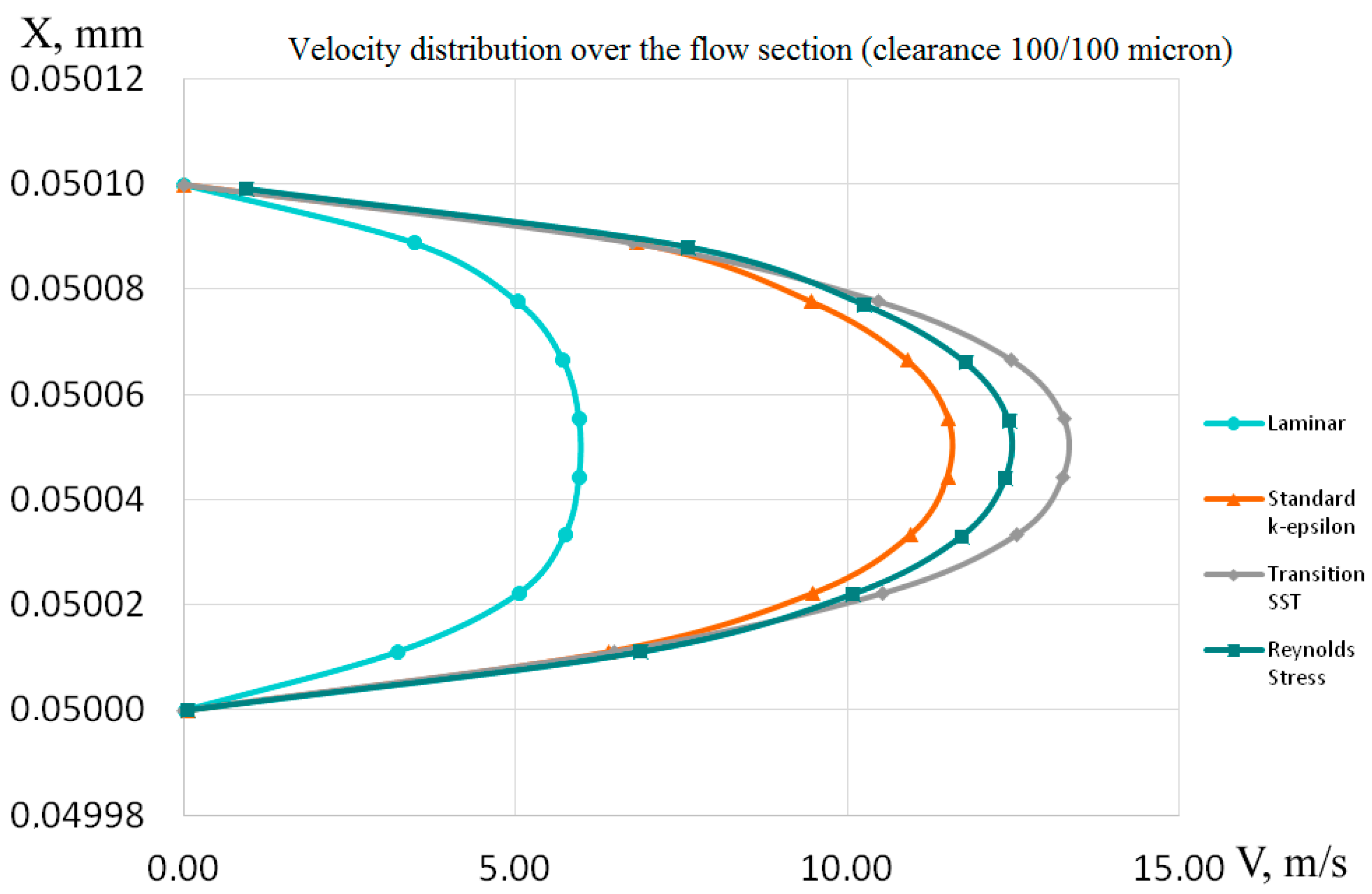

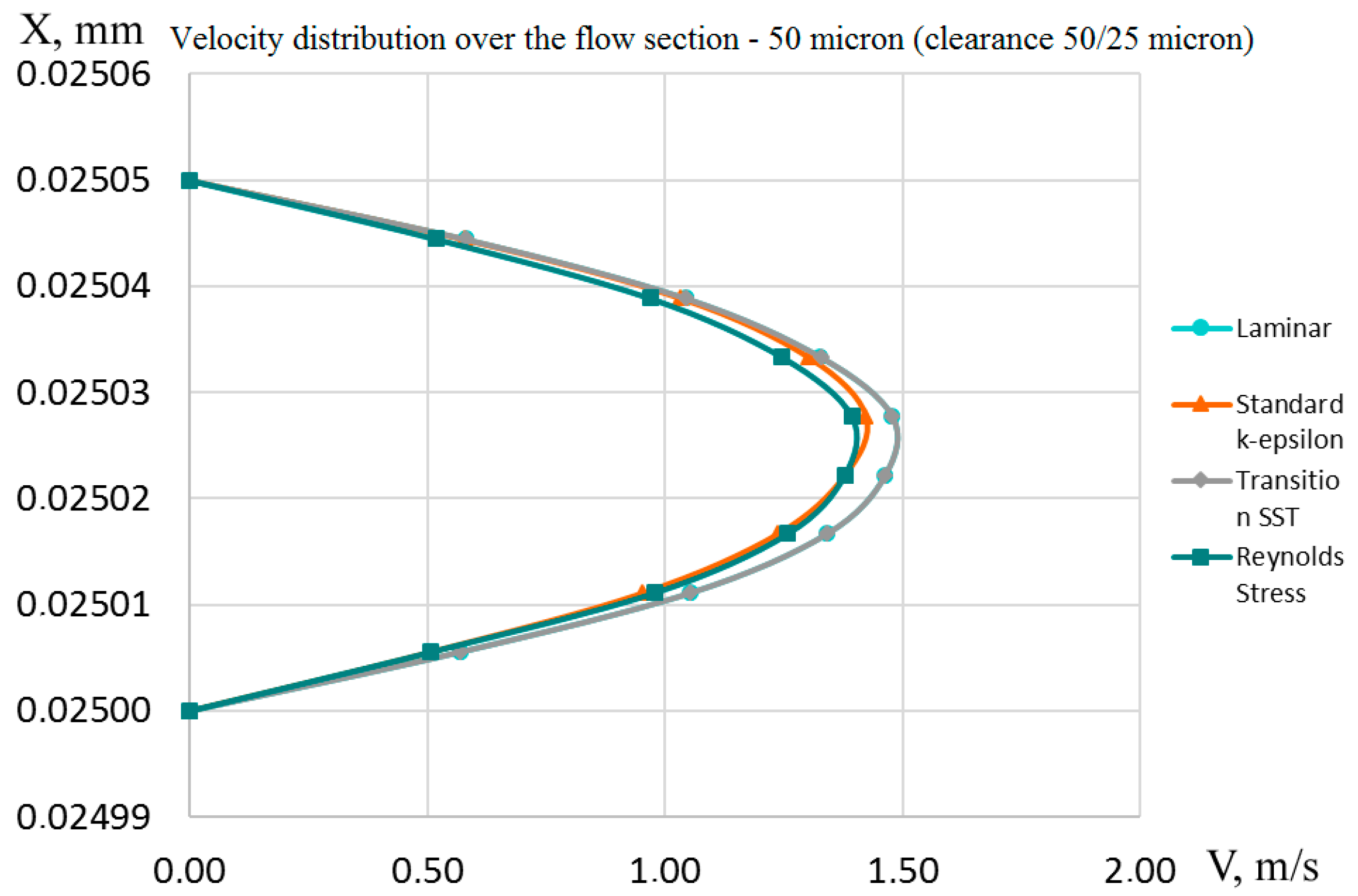


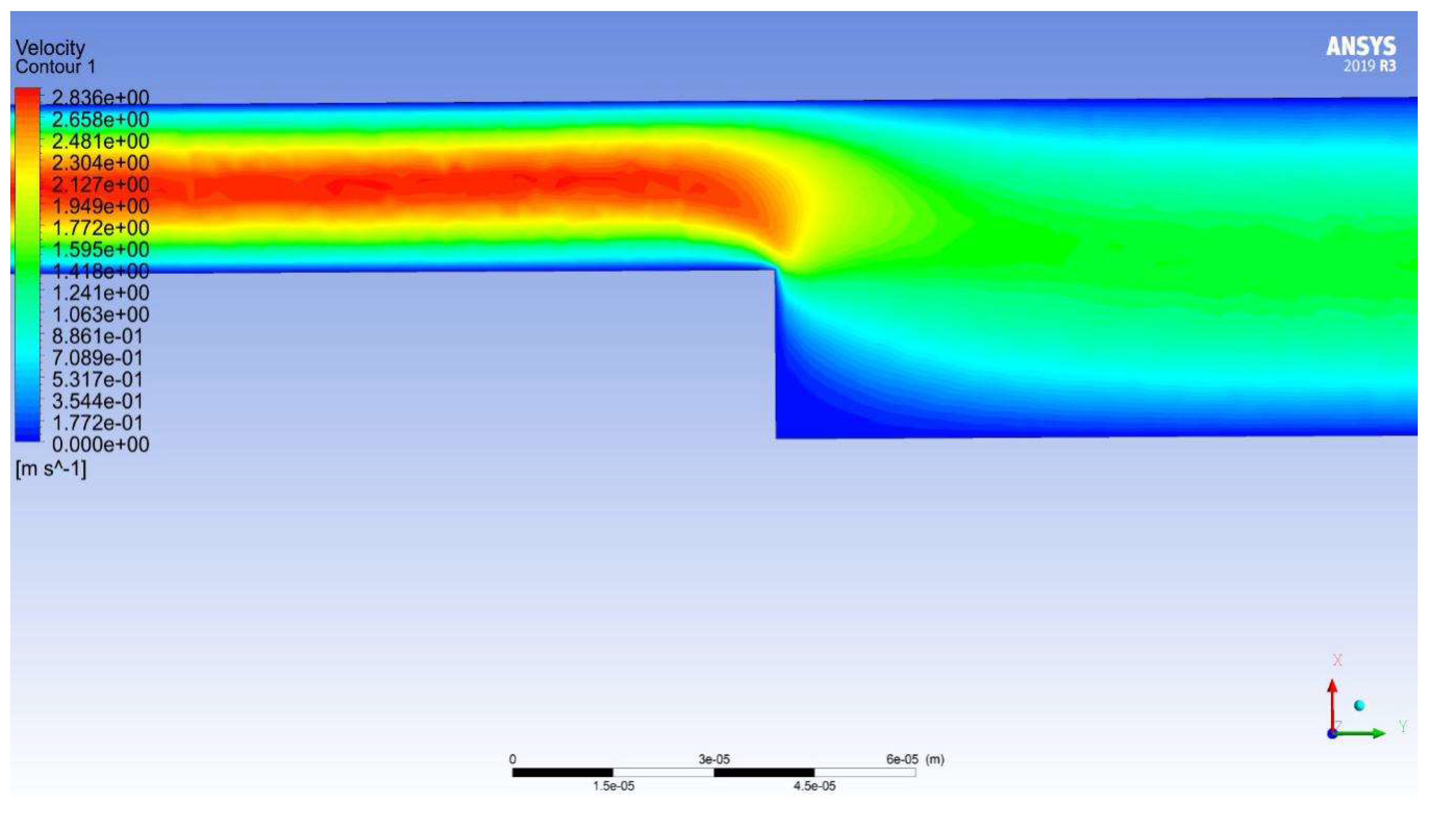

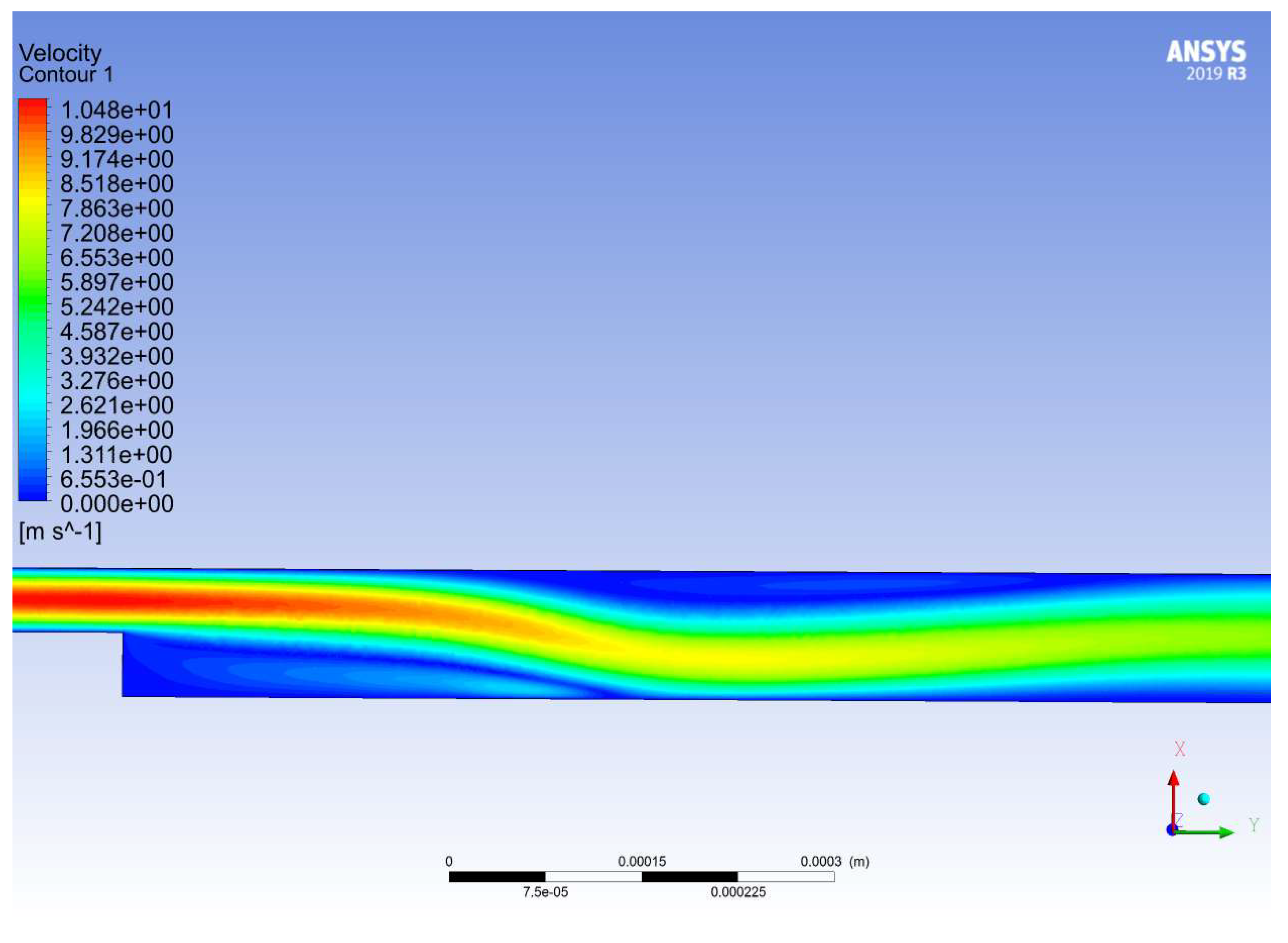
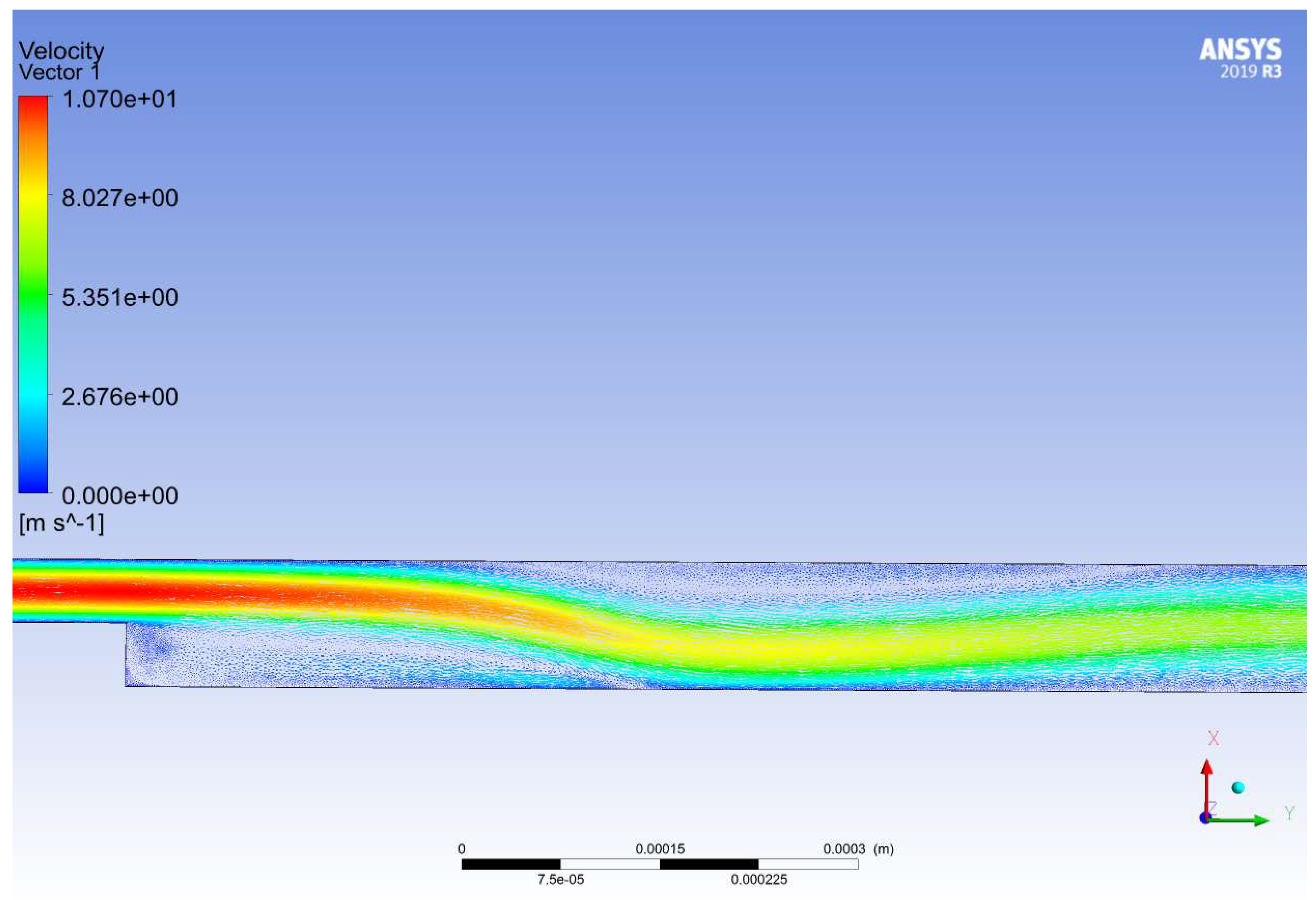

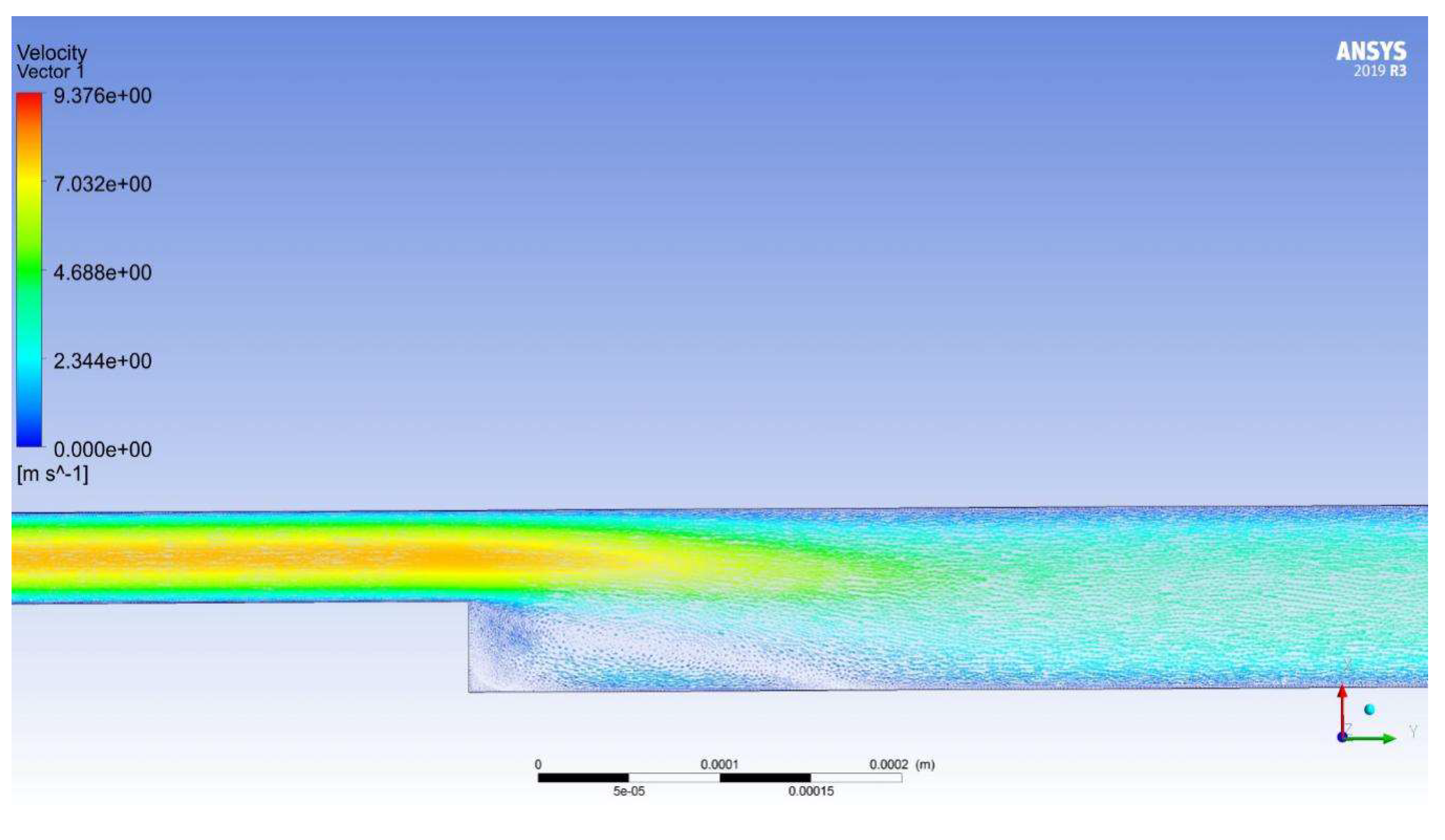
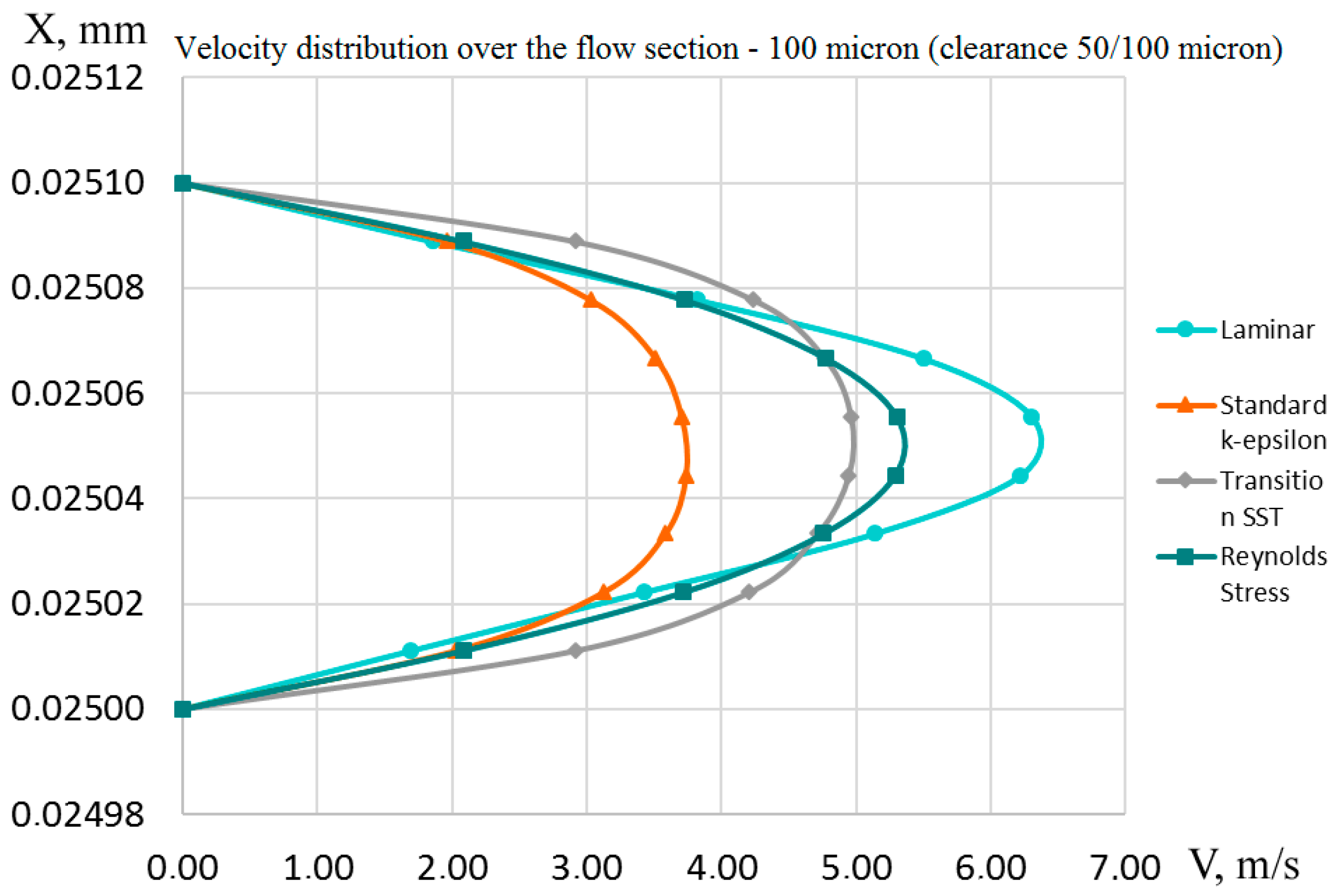

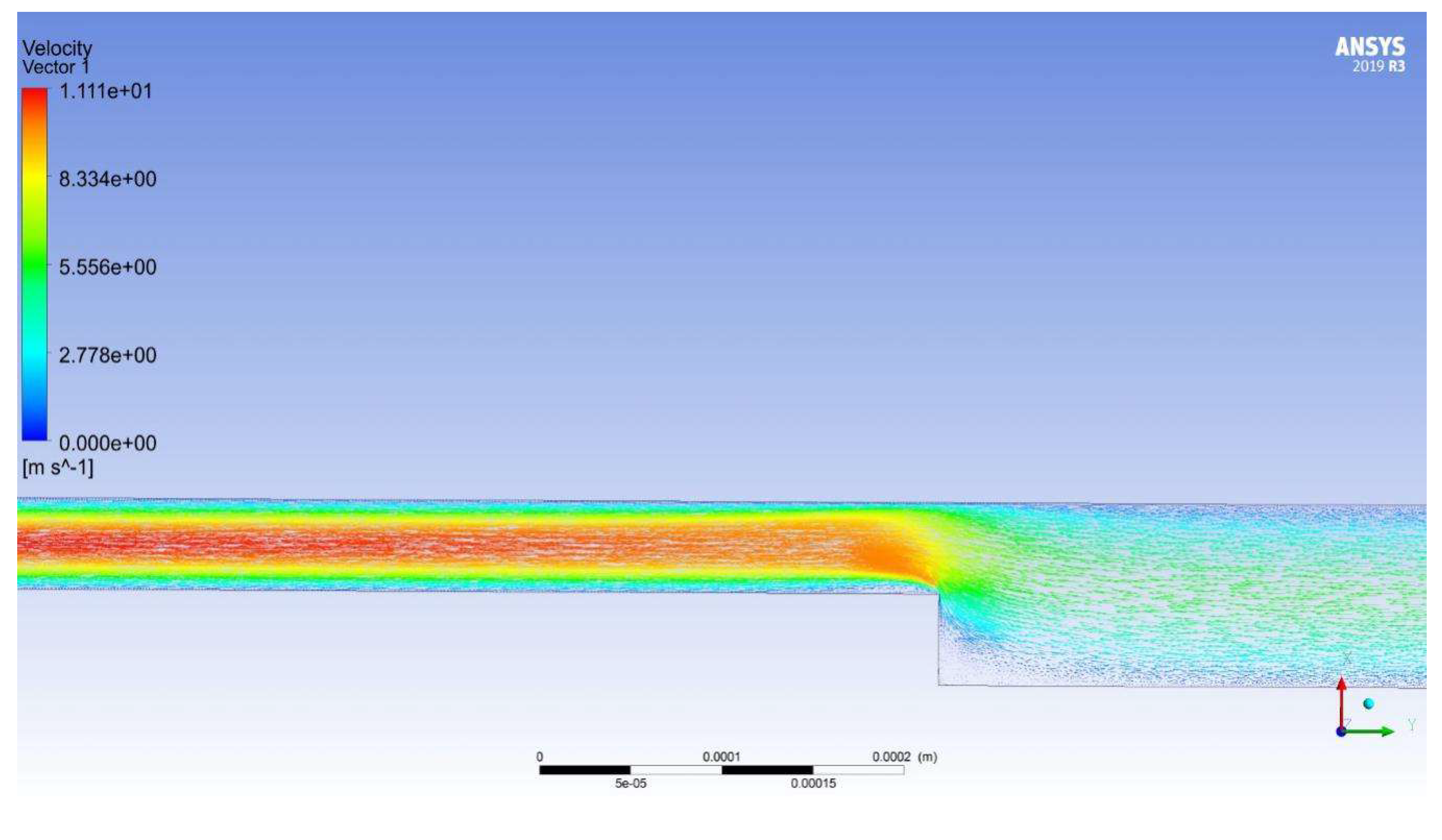
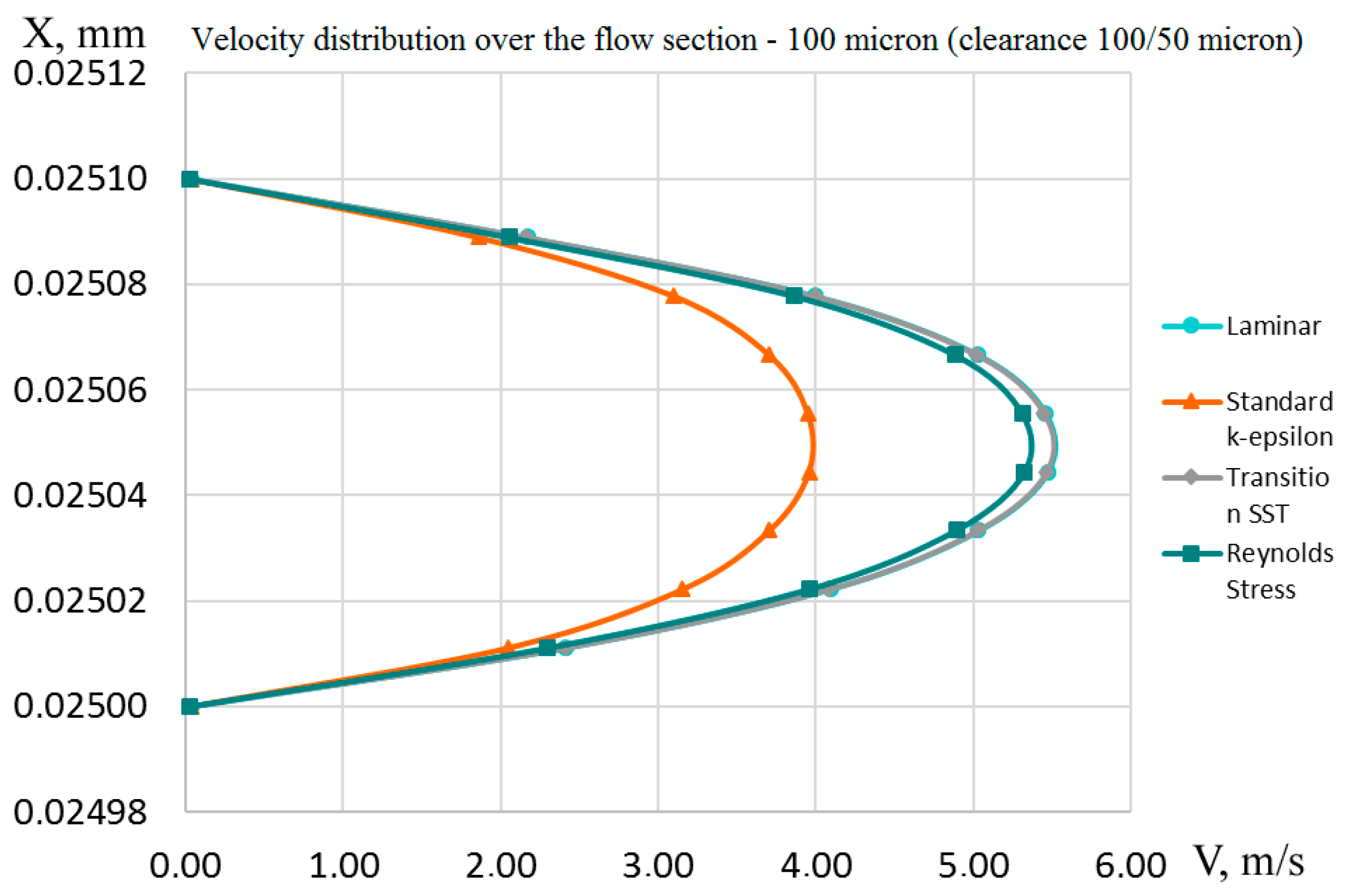
| Turbulence Models | The Size of the Gap Seal 50/50, Microns | |
|---|---|---|
| Vav, m/s | Re | |
| Laminar | 2.424 | 120.475 |
| Standard k-epsilon (input/output) | 3.707 | 184.25 |
| Transition SST (input/output) | 4.234 | 210.42 |
| Reynolds Stress (input/output) | 4.174 | 207.433 |
| Formula Consumption: | 3.74 | 185.887 |
| Turbulence Models | The Size of the Gap Seal (Input Flow/Output Flow), Microns | ||
|---|---|---|---|
| 25/50 | 50/25 | 50/50 | |
| Laminar | 0.008070 kg/s | 0.008036 kg/s | 0.018989 kg/s |
| Standard k-epsilon (input/output) | 0.007822 kg/s | 0.007304 kg/s | 0.029041 kg/s |
| Transition SST (input/output) | 0.008060 kg/s | 0.008031 kg/s | 0.033166 kg/s |
| Reynolds Stress (input/output) | 0.007428 kg/s | 0.007478 kg/s | 0.032695 kg/s |
| Formula Consumption: | −0.006507 kg/s | −0.006507 kg/s | 0.029299 kg/s |
| Turbulence Models | Sizes of Slotted Seals 100/100, Microns | |
|---|---|---|
| Vav, m/s | Re | |
| Laminar | 4.658079432 | 463.0298 |
| Standard k-epsilon (input/output) | 8.889252625 | 883.6235 |
| Transition SST (input/output) | 9.853676103 | 979.4907 |
| Reynolds Stress (input/output) | 9.510253468 | 945.3532 |
| Formula Consumption: | 11.67878943 | 1160.913 |
| Turbulence Models | The Size of the Gap Seal (Input Flow/Output Flow), Microns | ||
|---|---|---|---|
| 50/100 | 100/50 | 100/100 | |
| Laminar | 0.060259 kg/s | 0.059219 kg/s | 0.073149 kg/s |
| Standard k-epsilon (input/output) | 0.044047 kg/s | 0.045038 kg/s | 0.139594 kg/s |
| Transition SST (input/output) | 0.060051 kg/s | 0.059162 kg/s | 0.154739 kg/s |
| Reynolds Stress (input/output) | 0.056449 kg/s | 0.057229 kg/s | 0.149346 kg/s |
| Formula Consumption: | 0.053999 kg/s | 0.053999 kg/s | 0.1834 kg/s |
| Turbulence Models | The Size of the Gap Seal 50, Microns | |
|---|---|---|
| Vav, m/s | Re | |
| Laminar | 1.030141717 | 102.399773 |
| Standard k-epsilon (input/output) | 0.998484326 | 99.25291509 |
| Transition SST (input/output) | 1.028865209 | 102.2728836 |
| Reynolds Stress (input/output) | 0.948189922 | 94.2534714 |
| Formula Consumption: | 0.830623563 | 82.56695455 |
| Turbulence Models | The Size of the Gap Seal 50, Microns | |
|---|---|---|
| Vav, m/s | Re | |
| Laminar | 1.025801591 | 101.9683 |
| Standard k-epsilon (input/output) | 0.932361227 | 92.68004 |
| Transition SST (input/output) | 1.025163337 | 101.9049 |
| Reynolds Stress (input/output) | 0.954572461 | 94.88792 |
| Formula consumption: | 0.830623563 | 82.56695 |
| Turbulence Models | The Size of the Gap Seal 100, Microns | |
|---|---|---|
| Vav, m/s | Re | |
| Laminar | 3.837252847 | 381.4367 |
| Standard k-epsilon (input/output) | 2.804883522 | 278.8155 |
| Transition SST (input/output) | 3.824007546 | 380.12 |
| Reynolds Stress (input/output) | 3.594634593 | 357.3195 |
| Formula consumption: | 3.438620231 | 341.8112 |
| Turbulence Models | The Size of the Gap Seal 100, Microns | |
|---|---|---|
| Vav, m/s | Re | |
| Laminar | 3.771026342 | 374.8535131 |
| Standard k-epsilon (input/output) | 2.86798974 | 285.0884433 |
| Transition SST (input/output) | 3.76739662 | 374.4927058 |
| Reynolds Stress (input/output) | 3.644304472 | 362.2569058 |
| Formula consumption: | 3.438620231 | 341.8111562 |
| Motion Modes | Smooth Gap Seal | Step-Type Gap Seal | |||
|---|---|---|---|---|---|
| Forward Direction | Reverse Direction | Adequacy to Known Physical Concepts | |||
| Average Velocity and Rate | Diagram of Velocity Distribution in the Gap | Average Velocity and Rate | Average Velocity and Rate | ||
| Laminar flow | Standard k-epsilon; Reynolds Stress | Reynolds Stress; Transition SST | Reynolds Stress; Standard k-epsilon | Reynolds Stress; Standard k-epsilon | Reynolds Stress |
| Turbulent flow | Reynolds Stress; Transition SST | ---- | Reynolds Stress; Transition SST | Reynolds Stress; Transition SST | Reynolds Stress; Standard k-epsilon |
© 2020 by the authors. Licensee MDPI, Basel, Switzerland. This article is an open access article distributed under the terms and conditions of the Creative Commons Attribution (CC BY) license (http://creativecommons.org/licenses/by/4.0/).
Share and Cite
Shcherba, V.; Shalai, V.; Pustovoy, N.; Pavlyuchenko, E.; Gribanov, S.; Dorofeev, E. Calculation of the Incompressible Viscous Fluid Flow in Piston Seals of Piston Hybrid Power Machines. Machines 2020, 8, 21. https://doi.org/10.3390/machines8020021
Shcherba V, Shalai V, Pustovoy N, Pavlyuchenko E, Gribanov S, Dorofeev E. Calculation of the Incompressible Viscous Fluid Flow in Piston Seals of Piston Hybrid Power Machines. Machines. 2020; 8(2):21. https://doi.org/10.3390/machines8020021
Chicago/Turabian StyleShcherba, Viktor, Viktor Shalai, Nikolay Pustovoy, Evgeniy Pavlyuchenko, Sergey Gribanov, and Egor Dorofeev. 2020. "Calculation of the Incompressible Viscous Fluid Flow in Piston Seals of Piston Hybrid Power Machines" Machines 8, no. 2: 21. https://doi.org/10.3390/machines8020021





